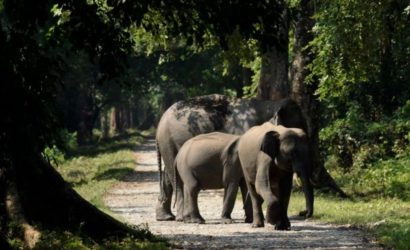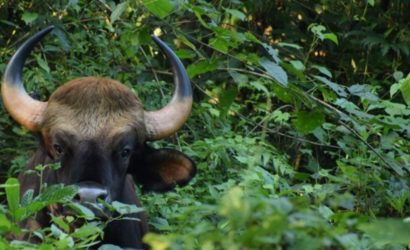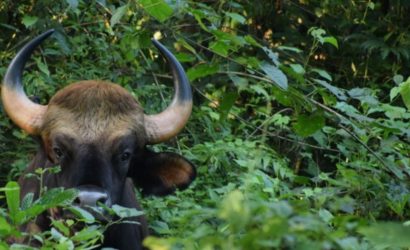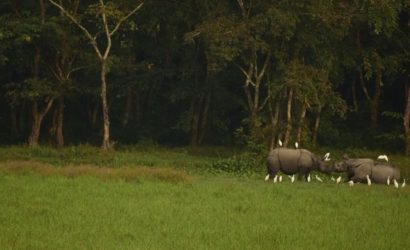Gorumara - Lataguri Circuit
Gorumara National Park – Lataguri – Murti – Chapramari Wildlife Sanctuary- Gajoldoba
Gorurmara National Park
Gorumara National Park is a prime national park of Dooars. Jaldhaka a tributary of Brahmaputra flows adjacent to the National Park. Ministry of Environment and Forest has declared Gorumara as the best among the protected areas in India for the year 2009. Gorumara was declared a reserve forest in 1895. In 1949 it was given a status of a wildlife sanctuary. Later on, Gorumara was declared as National Park in 1994. Gorumara National Park is spread over an area of approx 80 sq km. Gorumara has mixed vegetation of forest and grassland. It is one of the last refuges of One Horned Indian Rhino.
Wild Life at Gourmara
Gorumara is famous for its One Horned Rhino population. Herds of Elephant, Gaur, Chital, Sambhar are commonly seen during jungle safari. If luck favours you have a glimpse of the elusive – Leopard.
Major bird species seen in Gorumara include Minivets, Hornbills, Woodpeckers, Emerald Dove, Barbet, Cuckoos, Orioles, and Mynas. The night hunters in Gorumara are the Owls and the Nightjars.
Watch Towers at Gorumara
Jatraprasad : The watchtower is named after a female elephant which was legendary for its caring nature. The elephant Jatraprasad saved the lives of numerous orphaned baby elephants by acting like their mother. The entry point is through the National Highway at the northern part of Gorumara National Park. There are a couple of salt pits making it an attractive place for sighting wildlife especially during early morning and late afternoon safaris. It is one of the best watch towers to watch Indian Rhinoceros. There is another watchtower in the vicinity known as Rhino point.
Medla : It located at Kalipur eco-village near Ramsai on the eastern fringe of Gorumara National Park. From the gypsy drop point, you will be taken to the watchtower in a Bullock Cart. If you wish you may walk along the narrow path leading to the watchtower. Medla Watchtower is built on the vicinity of river Murti. Vegetation is primarily grassland and at the backdrop lies majestic Mt. Kanchenjunga which makes the watchtower one of the best for wildlife photography. From Medla Watch Tower you can watch the elephant herd crossing the river. Rhinos love the habitat around Medla due presence of shallow water bodies adjacent to the grassland. New grass comes up in the month of Jan-Feb, which draws Rhinos, Deer, Gaur to Medla. In the dry season in the month of April and May during the evening – Elephants, Gaur, Deer and Wild Boar can be seen at Medla as forest bound water sources day up and only water source left is the Murti River.
This watchtower is open for the tourist throughout the year.
Chapramari Watchtower : The watchtower located inside the Chapramari forest. From Khunia more you have to drive about 4 km towards the Jhalong – Bindu hills and then take a left road through the forests to reach Chapramari forest bungalow. The Watchtower is located just in front of the Bungalow. There is open grassland. Elephant and Gaur are common sightings from Chapramari watchtower.
In 2018 this watchtower was made open for the tourists throughout the year.
Chandrachur watchtower: If you drive from Murti River towards Khunia through the Chapramari forest, you will come across a road crossing. The road ahead goes towards Eastern Dooars and the road to your left will go to Khunia. If you take the forest road on your right and drive through for about a kilometre you will suddenly find yourself facing large open grassland and a watchtower in the middle of it. This is Chandrachur watchtower of Chapramari forest. There is a small pond and a salt pit. The open ground was originally the location of a forest village named Khunia Basti. The village was shifted outside the forest and the location slowly turned wild again as is evident from the games sighted here.
Chukchuki Watchtower: This watchtower is located inside the Gorumara forest between Ramsai and Lataguri. You will pass by and may stop over this watch tower during jungle safari.
Lataguri
Lataguri is a small town located in the Jalpaiguri district of West Bengal. The village is located outside the Gorumara National Park on National Highway No. 31. Lataguri made its mark as a prominent tourist destination of Dooars in the last decade. Gradually resorts and few home-stays has come up in the area. You may notice the last remnants of wooden houses. Permits for entering Gorumara and Chapramari Wildlife Sanctuary are issued from Lataguri. The village also contains a “Nature Interpretation Center”, which gives information about the flora and fauna of the area. Lataguri is the most favoured location of stay by the tourists visiting Dooars. You may visit the Mahakal Mandir from here. If you love sweets- don’t forget to taste sweets of Lataguri.
Murti
Murti is a picturesque place located in Jalpaiguri district of West Bengal, adjacent to Gorumara National Park. Murti river originating in the Neora Valley National park enhances the beauty of the place. The forest on the left bank is called Chapramari and the forest on the right bank known as Gorumara. Excellent scenic beauty is the main attraction of this place. Murti used to be the flooded with picnic parties during winter, however, after restrictions imposed, Murti has turned out to be a place where you will love to get lost into the wilderness. If you love adventure, want to be amidst pristine nature, it advisable you stay at Murti rather than at Lataguri. You may soak your feet at Murti river and take photographs at the iconic Murti Bridge. Elephant herds graze within the vicinity of Murti due to the presence of a large number of “Chalta” trees – the favourite food of elephant. If you are lucky, you may watch a herd of elephant crossing the Murti river.
Chapramari Wildlife Sanctuary
The name of the region comes from ‘Chapra’, a variety of small fishes found in Noth Bengal, and ‘Mari’, meaning ‘abundance’. On the west of Chapramari is the Murti river and on its east side is the Jaldhaka river. It relatively small forest (about 10 square km in area), but it’s one of the oldest in Dooars. In 1895 it was first recognized as a forest reserve due to its diversity in flora & fauna. Subsequently, in 1998 it became a wildlife sanctuary.
From 2018 Chapramari was made open for the tourists throughout the year.
Chapramari is near to Gorumara National Park and is more accessible from Murti than Lataguri. There is a Forest Bungalow and a Watchtower at Chapramari. There is a large grassland in-front of the tower and at the far end of the grassland, you can behold the beautiful Chapramari jungle. There is a water body and salt leak just in-front of the tower.
Presence of grassland, water body, and salt leak makes Chaprmari favourite haunting ground for both – predators and prey.
Wildlife at Chapramari – Wildlife commonly sighted at Chapramari is – Elephant, Gaur, Chital, Sambhar, and Wild Boar. If you are lucky you may see leopard also. Birds like White-throated Kingfisher, spoon-bill duck, green bee-eater, great cormorant are residents of Chapramari. In winter migratory birds like ruddy shell duck, coot, painted stork flock at Chapramari.
Permits for gypsy safari are issued from Murti and Lataguri.
Gajoldoba
Gajoldoba is a small village of Jalpaiguri District. It is a picturesque place adjacent to Teesta Barrage surrounded by Baikunthapur Forest. The prime attraction of Gajoldoba is Teesta Barrage and migratory birds. At the backdrop is the majestic Kanchenjunga. In winter from the Nov-Feb Gajoldoba becomes a birding paradise. Numerous water birds from Ladakh and Central Asia for instance Great Crested Grebe, Bar-headed Goose, Greylag Goose, Lesser Whistling Duck, Ruddy Shelduck, Common Shelduck, Cotton Teal, Little Grebe, Tufted Duck, Common Teal, Eurasian Wigeon, Spot-charged Duck, Mallard, Great Cormorant, Indian Cormorant, Little Cormorant, Indian Pond Heron, River Lapwing, Gray-headed Lapwing, Little Ringed Plover, and many more makes Gajoldoba their home.
There are few roadside dhabas at Gajoldoba. In the evening local people come with their products and sit along the canal. Gajoldoba is famous for a local fish called “Borouli”. Borouli Fry is readily available at stalls along the canal.
You may also visit Bodaganj(11 km from Gajoldoba). There is Bhamri Devi temple at Bodajanj. The temple premise has idols of Shiva and Parvati and a number of other deities. Locals as well as people from the surrounding area visit here in large numbers.









